Top 12 Must-Visit Sites in the Holy Land
- hawaritareq
- Aug 3
- 20 min read
Updated: Oct 9
Planning a trip to the Holy Land? Whether you're coming for a pilgrimage, a deep dive into ancient history, or to explore the breathtaking landscapes of Israel and the Palestinian Territories, this land offers a journey unlike any other.
As a licensed tour guide, I’ve walked these paths with travelers from all over the world—believers, seekers, and history lovers alike. From the sacred streets of Jerusalem to the mountaintop fortress of Masada and the healing waters of the Dead Sea, the Holy Land is a place where faith, history, and nature intertwine.
This isn’t just a destination—it’s a living story. Whether you're standing at the Western Wall, looking up at the magnificent Dome of the Rock, gazing across the reflection of the sun on the Sea of Galilee, or floating in the salty waters of the Dead Sea, every site leaves a lasting imprint on your soul.
Here are my top 12 must-visit locations—a blend of spiritual, historical, and natural wonders—that I believe everyone should experience on their journey through the Holy Land.
Kindly note that the order of sites presented here is organized for readability and practical flow. It does not reflect a ranking of religious importance or spiritual value, as the Holy Land holds profound meaning for many faiths and traditions.
1) Mount of Olives Observation Point & the Gethsemane
A panoramic gateway into Jerusalem's sacred story
The Mount of Olives offers one of the most iconic and spiritually charged views in the world. From this ridge east of Jerusalem’s Old City, you can take in the sweeping panorama of sacred history: the golden Dome of the Rock, the gray-blue domes of the Church of the Holy Sepulcher, and the ancient walls that have seen centuries of faith, conflict, and redemption.
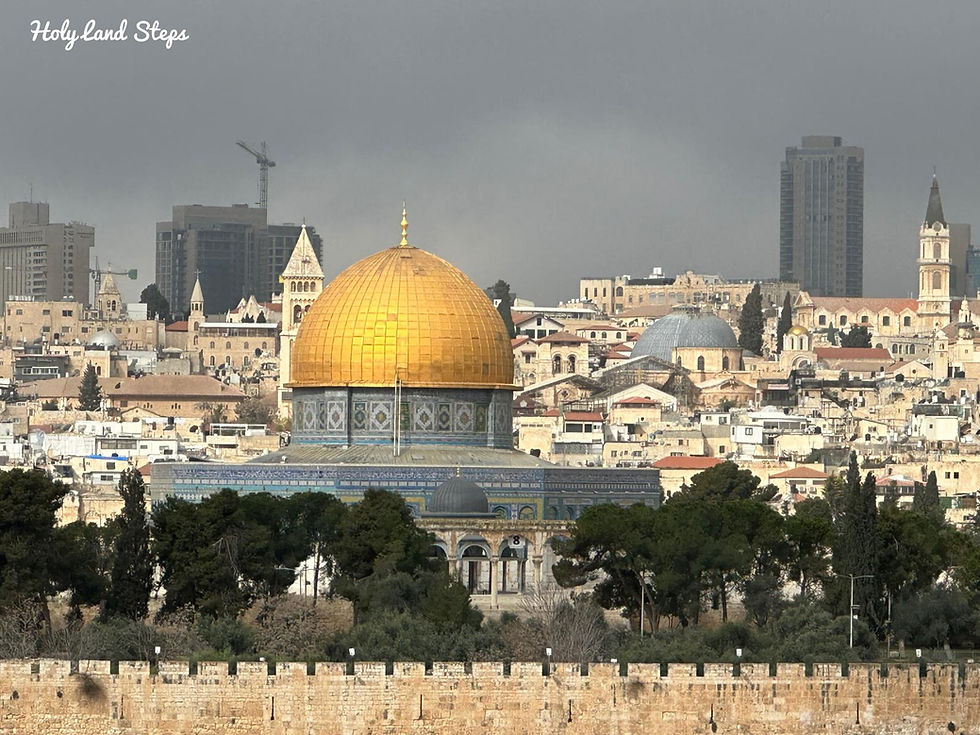
This spot holds deep significance in Christian tradition—Jesus wept over Jerusalem here (Luke 19:41), entered the city on Palm Sunday from this very hill, and later ascended to heaven nearby (Acts 1:9–12). It's also where many believe the final judgment will begin, as prophesied in Zechariah.
But the Mount of Olives is also profoundly important in Islamic tradition. Many Muslims believe it will be the place of resurrection and final judgment, and it’s revered for its proximity to Al-Aqsa Mosque and Haram al-Sharif. The shared reverence among the Abrahamic faiths makes this a place of powerful spiritual convergence.
A short walk down the hill leads to the Garden of Gethsemane, where ancient olive trees still stand. In this peaceful garden, Jesus prayed in anguish before His arrest—an emotional moment captured in the Gospels and honored in the Church of All Nations, which marks the site today.

Why Visit?
Unmatched panoramic view of Jerusalem’s Old City.
Sacred to Judaism, Christianity, and Islam.
Walking distance to major biblical sites like Gethsemane and Dominus Flevit Church.
Tour Guide Tips:
Don’t forget to take some of your best pictures here—with Jerusalem behind you, the golden Dome in the distance, and the timeless story unfolding beneath your feet. Morning and sunset are the most magical times to capture both the light and the feeling.
2) Church of the Holy Sepulcher - The Heart of the Christian World
No site in the Holy Land holds deeper meaning for Christians than the Church of the Holy Sepulcher. Located in the Christian Quarter of Jerusalem’s Old City, this extraordinary church is revered as the exact place where Jesus was crucified, died, was buried, and rose again. It is the spiritual center of the Christian faith—the holiest site in Christianity.
The moment you step inside, the air changes. There’s the heavy scent of incense, the warm flicker of oil lamps, the echo of chants in many languages. Pilgrims from around the world kneel, cry, sing, and pray side by side. It’s more than a building—it’s a living testimony of faith, devotion, and hope.

At the entrance lies the Stone of Anointing, where Jesus’ body was prepared for burial. Climb the stairs to Golgotha, the traditional site of the Crucifixion, and descend to the Aedicule, the shrine that encloses the empty tomb—where the Resurrection is believed to have occurred.
Unlike most churches, the Holy Sepulcher is not unified in style or administration. It is a unique composite structure, shaped by centuries of rebuilding and religious tension, and governed by the Status Quo—an agreement dating back to Ottoman times that regulates which Christian denominations control which spaces and when. Greek Orthodox, Roman Catholic (Franciscan), Armenian Apostolic, Coptic, Syriac, and Ethiopian communities all worship here, maintaining an often delicate coexistence.
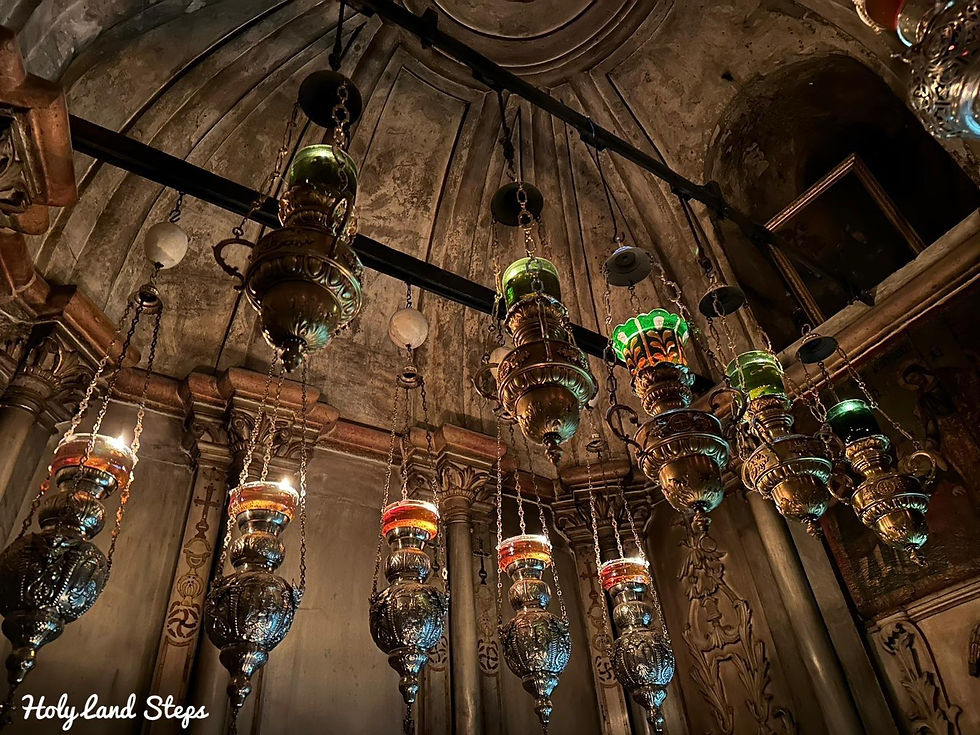
Beyond its main sites, the church hides spiritual and historical treasures:
The Chapel of St. Helena, buried deep beneath the surface
A quiet Coptic sanctuary tucked behind the Tomb
Ancient graffiti and crosses carved into the walls by early pilgrims
A peaceful rooftop courtyard used by the Ethiopian Orthodox monks
Why Visit?
The most sacred Christian site in the world.
Location of the Crucifixion, Burial, and Resurrection of Jesus.
A place where centuries of Christian worship converge in a single sacred space.
Tour Guide Tips: Visit in the early morning or during vespers to experience the church’s spiritual heartbeat. And don’t forget to look up—the light streaming through the dome, mixing with incense smoke, is one of the most powerful sights you’ll witness on your journey.
3) The Dome of the Rock and Al-Haram al-Sharif: A Jewel of Islamic Heritage
A Sacred Site of Islamic Faith and Spiritual Legacy
The Dome of the Rock, located within the vast Al-Haram al-Sharif complex in Jerusalem’s Old City, is one of the most historically and spiritually rich sites in the Holy Land. Revered primarily for its immense Islamic significance, this stunning shrine holds a central place in the hearts of millions of Muslims worldwide. The complex marks the location where, according to Islamic tradition, the Prophet Muhammad ascended to heaven during the Night Journey (Isra and Mi’raj), making it a focal point of faith and reverence.
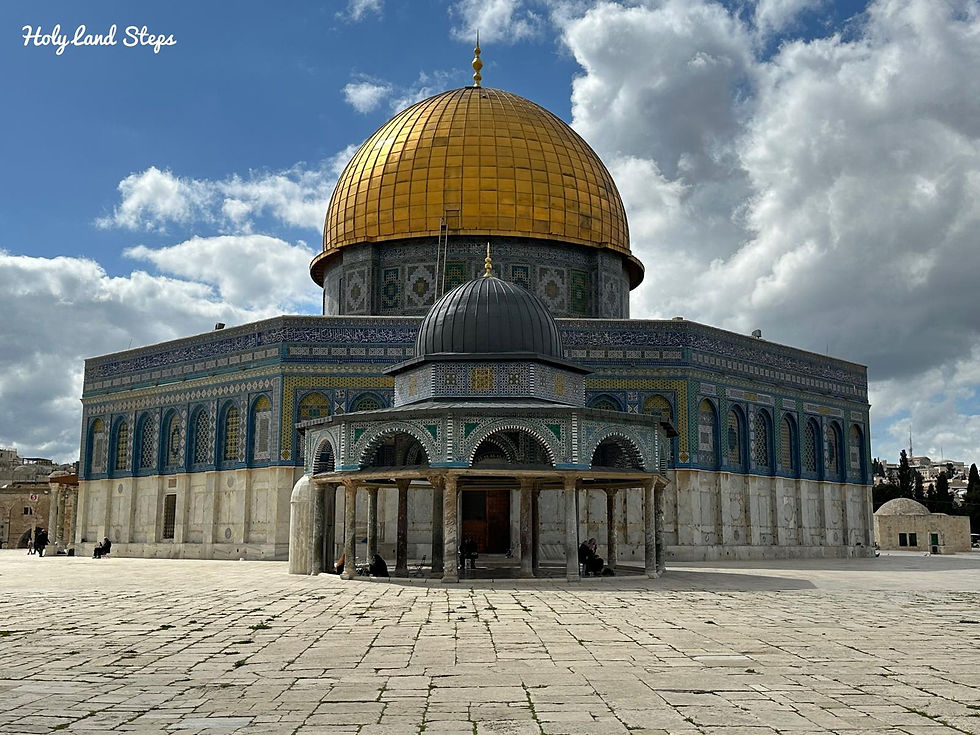
Iconic Beauty, Inscriptions, and a Living Tradition
One of the most striking features of the site is the Dome of the Rock itself, renowned for its radiant golden dome that gleams brilliantly under the Jerusalem sun. If you Google any picture of Jerusalem, you will most likely find the Dome of the Rock proudly shining in the skyline. This iconic dome can be captured from virtually every angle, offering breathtaking views and stunning photo opportunities throughout the day.
Encircling the octagonal structure of the Dome of the Rock are exquisite Arabesque Kufi inscriptions—ancient Arabic calligraphy that adorns the interior and exterior walls. These inscriptions are not only artistic masterpieces but also convey profound religious messages, connecting visitors with centuries of Islamic tradition and devotion.
The Dome of the Rock stands as one of the best examples of the continuation of ritual life throughout history. It remains a living site of worship and spiritual practice, linking the past and present in a timeless flow of faith.
Tour Guide Tips: Visitors should remember to wear modest clothing when visiting this sacred site, respecting its deep spiritual significance and the customs of the local community. Non-Muslim visitors may enter the complex only through the Dung Gate, but they can exit through any of the other gates.
4) The Western Wall - Jerusalem’s Sacred Heartbeat and Spiritual Anchor
A Sacred Space of Prayer, Memory, and Tradition
The Western Wall—also known as the Kotel, Al Buraq or the Wailing Wall—is one of the most sacred and iconic sites in the Holy Land. This ancient limestone wall is the last surviving remnant of the Second Jewish Temple, destroyed nearly 2,000 years ago, and remains a powerful symbol of Jewish faith, history, and resilience.
Located in the Old City of Jerusalem, the Western Wall serves as a vibrant place of prayer and reflection for Jews and visitors from around the world. Pilgrims come to place handwritten prayers into the cracks of the stones, seeking blessings, healing, and spiritual connection.
Upon entering the plaza, men traditionally turn left to see a remarkable series of ancient arches supporting the southern end of the Wall. These arches form the foundation of the Muslim Quarter, highlighting Jerusalem’s rich, layered history where diverse faiths and cultures coexist.

Living Rituals, Bar Mitzvahs, and Timeless Spirituality
The Western Wall is also known for its Bar Mitzvah ceremonies, a heartfelt coming-of-age celebration for Jewish boys turning 13. These ceremonies, often held right at the Wall, include reading from the Torah, prayers, and blessings, offering a glimpse into vibrant Jewish tradition.
At the Wall, many worshippers gather in small groups, wearing prayer shawls, kippot, and tefillin as they engage in prayer and reflection. This creates a deeply spiritual and communal atmosphere, inviting visitors to observe or join in the moment of devotion.
The Western Wall stands not only as a historic landmark but as a living testament to enduring faith and hope, making it an essential stop for anyone exploring the Holy Land.
Tour Guide Tips: The Western Wall plaza is open 24 hours a day, welcoming visitors around the clock. The experience of visiting by day or night is profoundly different yet equally moving. At night, the softly illuminated stones and peaceful stillness create an unforgettable moment of quiet reflection and spiritual connection.
5) The Garden Tomb: A Peaceful Encounter with the Resurrection Story
Just a short walk from Jerusalem’s Old City lies one of the most serene and spiritually moving places in the Holy Land—the Garden Tomb. Regarded by many as an alternative site to the Church of the Holy Sepulcher, the Garden Tomb offers a unique opportunity to experience the biblical story of Jesus’ crucifixion, burial, and resurrection in a setting marked by silence, simplicity, and natural beauty.
A Quiet and Reflective Experience
While the Church of the Holy Sepulcher is filled with ancient tradition and reverence, it can also be crowded, noisy, and overwhelming. The Garden Tomb, in contrast, offers a peaceful atmosphere, free from long lines and heavy foot traffic. It invites visitors to slow down, reflect, and connect with the Gospel in a deeply personal way.
The garden is beautifully maintained, with vibrant flowers blooming throughout the year, shaded walkways, and a calm sense of stillness. It’s a place where spirituality, silence, and even a touch of romance come together in the gentle rhythm of nature. (The gardener is a friend of mine and someone I know well—his thoughtful care is part of what makes the place so warm and beautiful.).

The Empty Tomb and the Wine Press
At the heart of the site is an ancient rock-cut tomb, thought by many to resemble the one described in the Gospels. Visitors can peer inside the empty tomb, see its carved interior, and stand before a round stone nearby—evoking the resurrection story.
Also on the grounds is a small ancient wine press, a reminder of the area’s agricultural past and another connection to everyday life in biblical times.
A Sacred Garden Just Minutes from the Old City
Located just outside Damascus Gate, the Garden Tomb is within easy walking distance from the Old City. Yet once inside, the city noise fades, and a spirit of peace takes over. It’s a space where visitors of all backgrounds can reflect, pray, and experience the message of hope in their own way.
The Garden Tomb may not be the historically confirmed site of Jesus’ burial, but for countless visitors, it offers something just as important: a sacred space to encounter the story of the resurrection in silence, beauty, and personal reflection. It’s one of Jerusalem’s most meaningful and quietly powerful stops.
Tour Guide Tips: Mornings or late afternoons are quieter and cooler, especially in summer — ideal for peaceful reflection and better photos. Take a few minutes in silence among the colorful flowers and olive trees. Many visitors say the peaceful atmosphere here stays with them.
6) The Dead Sea: Earth’s First Natural Spa and a One-of-a-Kind Experience
The Dead Sea isn’t just a place—it’s a phenomenon. Located just 45 minutes from Jerusalem, this iconic body of water is the lowest point on earth, sitting over 430 meters (1,400 feet) below sea level. For thousands of years, people have come to its shores seeking rest, healing, and beauty—and the experience remains just as powerful today.
A Spa Known Since Ancient Times
The Dead Sea is often considered the first natural spa in the world. Even Cleopatra, the legendary queen of Egypt, recognized its value. She is believed to have used its minerals and mud as part of her famed beauty regimen—proof that the sea’s healing properties have been treasured since antiquity.
The water is incredibly rich in minerals like magnesium, calcium, and potassium, which are known for their therapeutic benefits. The air is dry and rich in oxygen, the sun is gentle due to the thick atmosphere, and the mud—thick, dark, and nutrient-dense—is like nature’s original skincare treatment.

Float, Relax, and Take the Perfect Photo
One of the most iconic experiences at the Dead Sea is floating effortlessly on your back. Thanks to the water’s extremely high salt concentration, you’ll stay buoyant without any effort. Many visitors enjoy the classic moment of floating while reading a book—a perfect photo opportunity that’s become a signature Dead Sea memory.
Then there’s the mud. Visitors love covering themselves in the famous Dead Sea mud, letting it dry on their skin like a natural mask. It’s great for your skin—and for your camera roll. Don't be surprised if you find yourself taking pictures looking like a mud-covered ninja turtle—it’s all part of the fun!
Health and Healing in Every Drop
Whether you're easing sore muscles, treating skin conditions, or simply looking to unwind, the Dead Sea offers genuine health benefits. Many visitors report feeling rejuvenated after a short soak, and even a brief visit can leave your skin feeling smoother and refreshed.
A short drive from Jerusalem, the Dead Sea is not just a destination—it’s an ancient spa, a natural wonder, and a joyfully bizarre bucket-list moment all in one. Don’t miss it.
Tour Guide Tips: There truly is no other place in the world where you can float like this, coat yourself in healing mud, breathe such uniquely rich air, and bask in the desert sun—all while surrounded by dramatic landscapes and biblical history. The Dead Sea is a once-in-a-lifetime experience that touches the body and soul. Drink lots of water while visiting the Dead Sea — just not that water!
7) The Church of the Nativity: Stepping into the Mystery of the Incarnation
In the heart of Bethlehem, just a short distance from Jerusalem, stands one of the most sacred and moving sites in the Christian world—the Church of the Nativity. This revered basilica, built over the spot where Jesus is believed to have been born, invites visitors into a moment that changed the course of human history.
A Humble Entrance, a Timeless Encounter
As you approach the church, the first thing you’ll notice is the low doorway—the Door of Humility—through which all visitors must bow to enter. This simple act, whether intentional or symbolic, sets the tone for what lies inside: a sacred space that humbles the heart and lifts the soul.
Once inside, time seems to shift. The light filters through ancient windows and illuminates rows of majestic stone columns, their capitals dating back nearly 1,500 years. These silent witnesses have stood through centuries of history—generations of pilgrims, prayers, empires, and faith.
Beauty and Reverence in Every Corner
The interior is a blend of deep reverence and rich tradition. The Greek Orthodox iconostasis, adorned with gilded icons and hanging lamps, creates a visual harmony of art and devotion. It separates the nave from the sanctuary, drawing the eye and spirit toward the sacred mysteries at the heart of Christian worship.
The Birthplace of Christ: A Sacred Descent
Visitors then make their way down a set of worn stone steps into the Grotto of the Nativity, the cave where, according to tradition, Jesus was born. There, embedded in the stone floor, lies the silver star of Bethlehem, marking the exact spot of the Nativity, inscribed with the Latin words: "Hic de Virgine Maria Jesus Christus natus est"—Here Jesus Christ was born to the Virgin Mary.
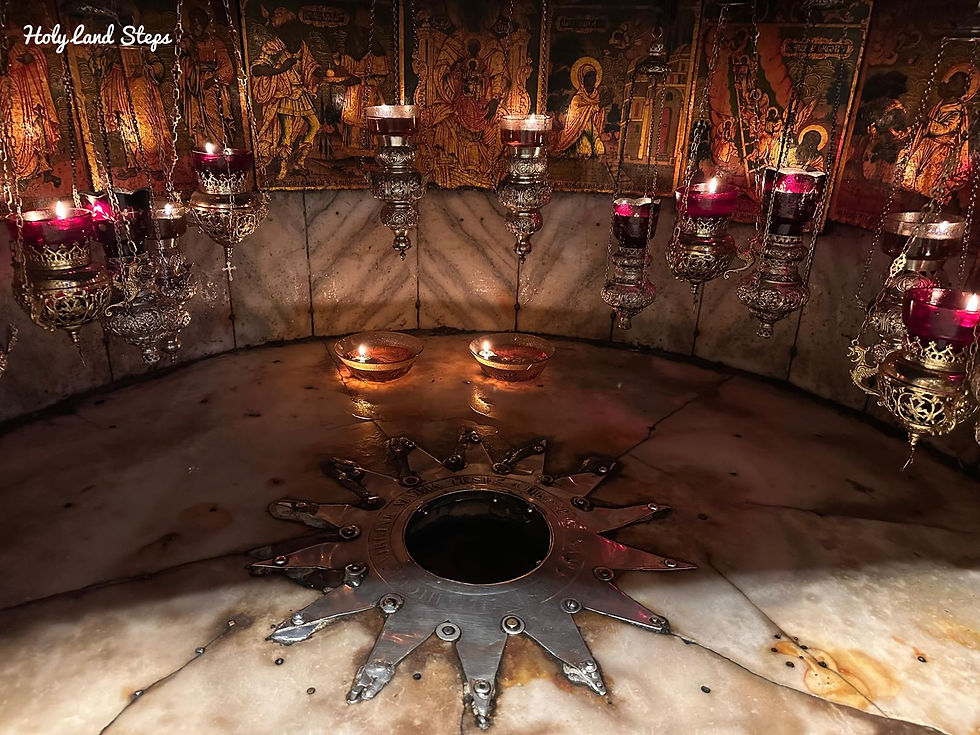
Just a few steps away is the manger, a niche carved into the stone, believed to be where Mary laid her newborn son. The quiet here is profound, often filled only with whispered prayers or silent awe. This is the fulfillment of prophecies spoken in the Old Testament—an event that brought light into a world longing for redemption.
The Church of the Nativity is more than a historical monument—it's a living witness to the divine entering human history. It is a place where heaven and earth meet, and where every visitor, regardless of background, can pause and reflect on a moment that transformed the world forever.
Tour Guide Tips: Don't forget to bring your passport, as you'll be crossing from Jerusalem into Palestinian-controlled Bethlehem.
8) The Sea of Galilee: A Place Where Scripture Comes Alive
I’ve guided tours around the Sea of Galilee dozens of times, and yet each visit feels as fresh and moving as if it were only my second. This is one of those rare places where, the closer you get to the water, the more clearly you can hear your own heartbeat—a space where silence speaks, and the landscape invites deep reflection.
The Sea of Galilee is where your imagination naturally begins to draw scenes from the Gospels. You can almost see Jesus walking on the water, calming the storm, calling His disciples, healing the sick, feeding the multitudes, and teaching the Sermon on the Mount from the hills nearby. The spiritual weight of these stories lingers in the air and over the calm, rippling waters.

To truly connect with the place, consider booking a boat ride across the lake. As you sail, you’ll be gliding over the same waters Jesus once crossed—surrounded by the Galilee hills to the west and the Golan Heights to the east, just as He would have seen them. It’s a profound moment of connection, both historical and spiritual.
The beauty of the Sea of Galilee changes with the seasons. In summer, the lake shimmers a deep, vibrant blue under the bright sky. In winter, with the clouds hanging low, the water takes on a peaceful green hue. Whether bathed in sun or wrapped in mist, the view is always breathtaking.
The Sea of Galilee is not just a destination—it’s a sacred experience. A place where the biblical narrative becomes more than a story, and where every breeze, wave, and horizon point draws you deeper into its timeless mystery.
Tour Guide Tips: Bring a hat, sunscreen, and sunglasses — the sun can be intense, especially on boat rides. Also wear modest clothing if visiting nearby churches like Tabgha, Capernaum, or the Mount of Beatitudes. Whether on the shore or during a boat ride, pause in silence. Many pilgrims describe this moment as the most spiritually moving part of their trip.
9) Masada: A Desert Fortress of Defiance, Vision, and Majesty
Rising dramatically above the Judean Desert and the shores of the Dead Sea, Masada is more than just a mountain—it is a symbol of resilience, vision, and genius. Recognized as a UNESCO World Heritage Site, Masada is one of the most breathtaking and historically powerful places in the Holy Land.
The Last Jewish Stronghold and a Roman Siege Frozen in Time
Masada was the last Jewish stronghold during the Great Revolt against the Romans in 73 CE. At the foot of the mountain, you can still see the remains of the Roman camps and siege ramp—a haunting reminder of one of the most dramatic and tragic episodes in Jewish history. Standing on the plateau, it's easy to imagine the tension and courage that filled this place nearly 2,000 years ago.
Herod’s Desert Dream: Madness or Masterpiece?
Long before the siege, King Herod the Great chose this remote, isolated plateau to build one of his most ambitious architectural projects—a fortified desert palace complex that defied logic and climate. From his bed, he could gaze straight into the heart of the desert, turn his head left to see the mountains, turn his head right to see the Dead Sea glistening, and look up at night to see a sky ablaze with stars untouched by city lights.
Among his many extravagances, Herod even built an Olympic-sized swimming pool—right on top of the mountain, in a place that receives almost no rain. The ingenious water system he devised to collect and store runoff from flash floods remains one of the most advanced ever built in this region.
A Cable Car Ride Through Time—and an Unforgettable Sunrise
Visitors can ascend Masada by foot via the Snake Path or take the cable car, which offers a stunning journey from the desert floor to the summit in just a few minutes. The view unfolds dramatically as the mountain drops away behind you and the Dead Sea expands into the horizon.

If you're an early riser, witnessing the sunrise from Masada is an experience that stays with you forever. As the first light spills over the mountains of Moab, painting the desert in gold and pink, the silence and beauty of the moment speak louder than words.
Masada is a place where history, nature, and human spirit meet—where Herod’s architectural ambition, the heroism of the Jewish rebels, and the raw beauty of the desert combine into one unforgettable experience.
Tour Guide Tips: Especially in spring and summer, visit early in the morning. It’s cooler, less crowded, and the light over the desert is stunning — perfect for photos and reflection. The cable car is fast and easy, great for all fitness levels. Adventurous visitors can hike the Snake Path (about 45–60 minutes uphill) — but only early in the day and with proper gear.
10. Magdala: Unearthing the Living History of the Second Temple–Roman Period
Situated right on the shores of the Sea of Galilee, Magdala is one of the most remarkable archaeological discoveries in recent decades. This ancient city, uncovered quite by chance during the construction of a hotel, offers an unparalleled glimpse into a well-preserved Second Temple–Roman period city—an extraordinary window into the world Jesus and His followers knew.
The Birthplace of Mary Magdalene and a Living Synagogue
Magdala holds profound spiritual significance as the birthplace of Mary Magdalene, one of Jesus’ most devoted followers. Visitors can walk through the ancient streets and feel a direct connection to this powerful figure of faith.
One of the site’s most extraordinary features is the Second Temple period synagogue, remarkably intact and centered around the famous Magdala Stone. This unique artifact gives us one of the very few tangible links to Jewish worship during Jesus’ time. It’s easy to imagine Jesus himself sitting in this synagogue, preaching—as the Gospel of Matthew describes—and teaching those who gathered there.
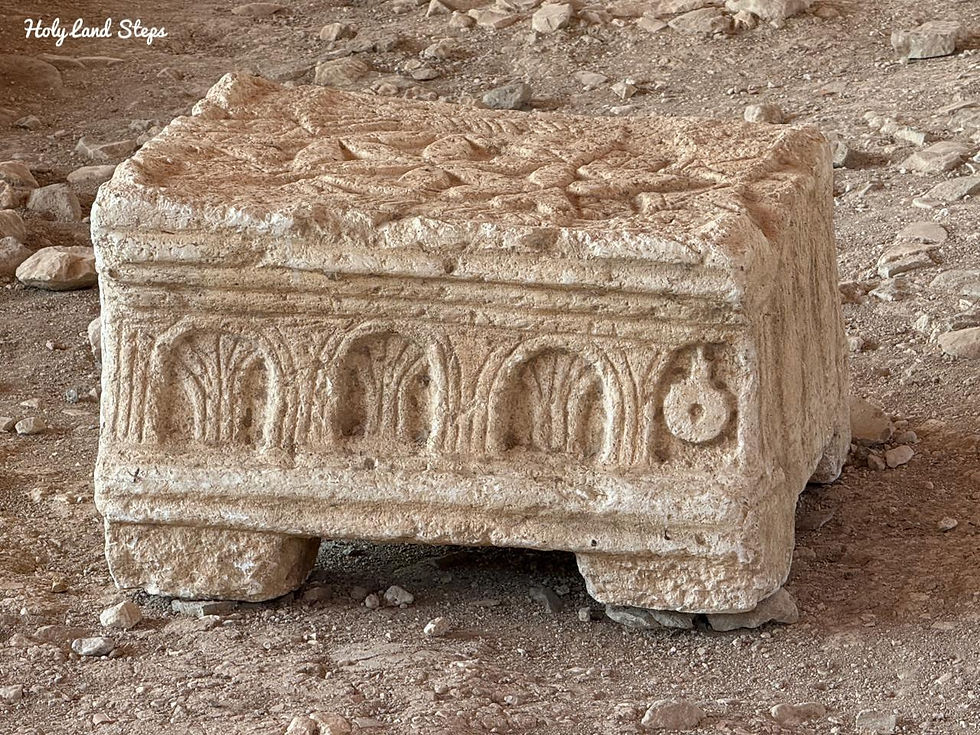
Chapels Reflecting Moments of Grace and Healing
The newly constructed chapels on the site invite quiet reflection on many important events from the Gospels. Particularly moving is the Chapel of the Boat, which symbolizes Jesus’ ministry by the water and His calling of the fishermen disciples.
In the lower floor of the building, the beautiful painting of the bleeding woman touching Jesus’ cloak captures a moment of deep faith and healing, inviting visitors to step into the story and feel the power of Jesus’ compassion and grace.
Tour Guide Tips: Don't miss the First - Century synagogue and remember to pause in the Encounter Chapel. Take time to walk around the site — you can even reach the sacred shores of the Sea of Galilee.
11) Banias (Caesarea Philippi) : Where Nature, History, and Faith Converge
About an hour’s drive from the Sea of Galilee, nestled in the scenic Golan Heights, lies the remarkable site of Banias, also known as Caesarea Philippi. While the Golan Heights can sound intimidating to some visitors, Banias itself is extremely safe and welcoming to tourists. This unique location beautifully combines nature, archaeology, and biblical history into one unforgettable experience.
At the heart of Banias is a powerful spring, one of the main sources that forms the Jordan River. Surrounded by lush trees and vibrant greenery, the area offers peaceful hiking trails that wind through the landscape, inviting visitors to explore both its natural beauty and historical significance.

Perched above the springs are the remains of ancient pagan temples, reminders of the site’s importance in pre-Christian times as a center of worship for the god Pan.
Most importantly for Christian pilgrims, Banias is the setting of one of the most pivotal moments in the Gospels — where Jesus asked His disciples, “Who do you say that I am?” and Peter made his confession of faith. This biblical scene gives the site deep spiritual meaning and draws many visitors seeking to connect with the roots of their faith.
Tour Guide Tips: The site offers beautiful nature paths, including a scenic route to the Banias waterfall. Allow extra time to enjoy the peaceful surroundings. The trails around Banias can be rocky and uneven. Comfortable hiking shoes will make exploring much easier.
12) Tel Dan: A Natural and Archaeological Treasure in the Upper Galilee
A Paradise Chosen by the Tribe of Dan
Just a few minutes’ drive from Banias, you’ll arrive at one of Israel’s most breathtaking natural and archaeological sites — Tel Dan. Nestled close to Mount Hermon and located at the strategic triangle where Israel, Syria, and Lebanon meet, this vast open space is often described as a paradise on earth. It perfectly explains why the spies sent by the tribe of Dan chose this fertile land as their new home (Judges 18).
Tel Dan offers stunning panoramic views over the Upper Galilee, with lush greenery and cool, shaded trails inviting visitors to explore. Among its highlights are the walking paths that lead to one of the key sources of the Jordan River — a river whose very name comes from the word “Dan.”
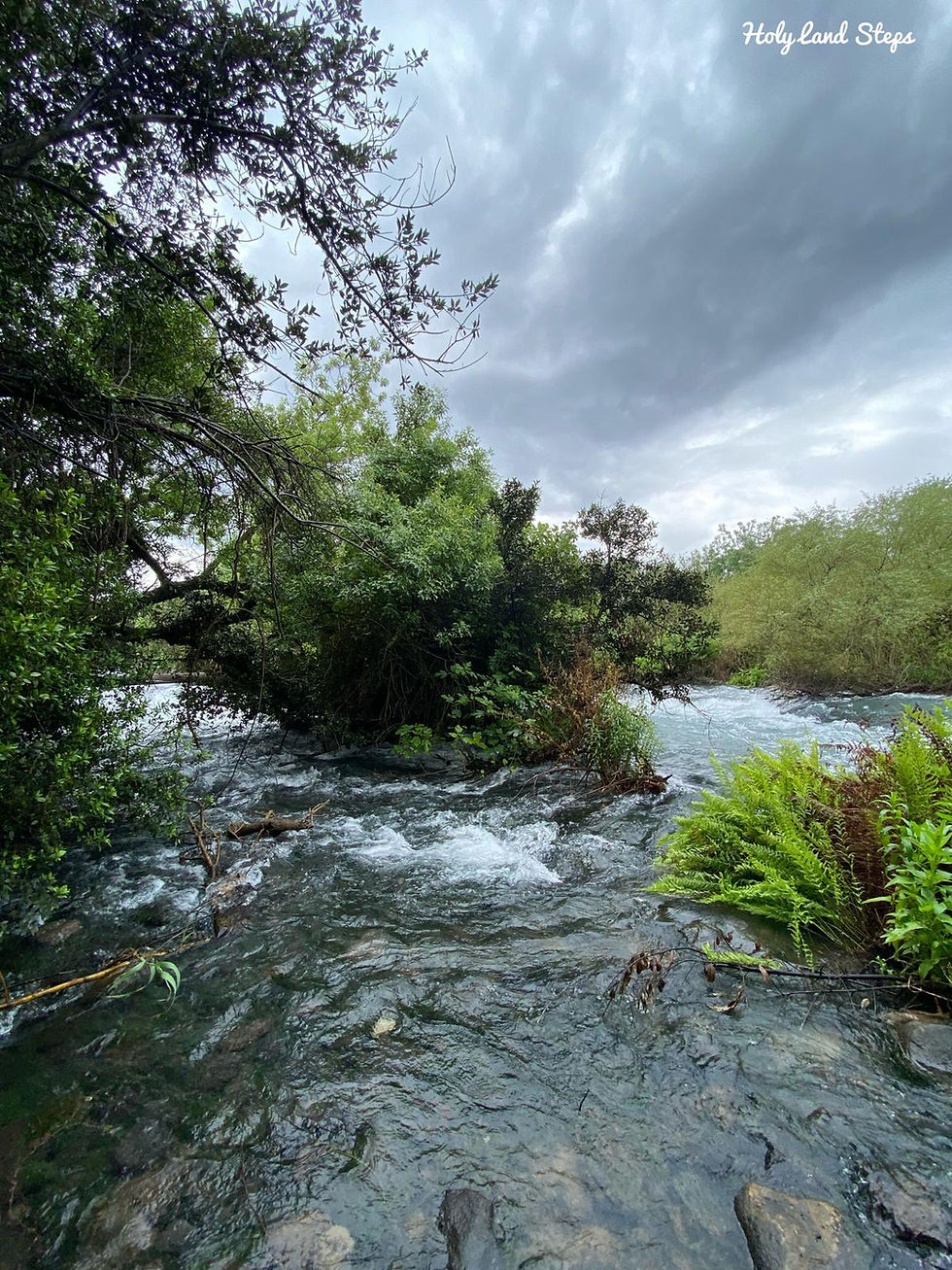
The Jordan River’s Powerful and Clear Source
What makes the Dan River particularly remarkable is its strong, clear, and constant flow, fed by abundant underground springs. This steady water supply has made Tel Dan a vital and vibrant ecosystem, supporting both ancient settlements and rich wildlife.
Archaeological Wonders: Black Basalt, Ancient Gates, and Historic Inscriptions
You’ll also find an impressive archaeological area built from distinctive black basalt stone, featuring ancient city gates that stand as powerful testaments to Tel Dan’s long and rich history.
One of the most significant discoveries here is the Tel Dan Inscription, an ancient artifact that mentions the “House of David,” providing crucial evidence of the biblical dynasty’s existence.
Another remarkable highlight is the Abraham Gate, considered the oldest arched gate still standing in Israel, dating back to the Canaanite period. This impressive structure offers a rare glimpse into the architectural skill and urban development of ancient times.
Tour Guide Tips: Tel Dan offers various walking paths—from easy strolls to longer forest hikes. Choose the ones where you cover both nature and history. The scenery, archaeological sites, and wildlife make Tel Dan a photographer’s delight so make sure to bring a good camera or a smartphone.
After exploring the rich layers of history, faith, and natural beauty that define the Holy Land, it’s clear that this journey is unlike any other. Each site carries its own story, its own sacred energy, and together they create a mosaic that speaks to the heart and soul. Whether you walked ancient paths, floated on the Dead Sea, or stood where history was made, these experiences stay with you long after you leave. The Holy Land challenges us to connect—to the past, to our beliefs, and to one another—in ways that are profound and personal. I hope this guide inspires you to embark on your own journey here, one that will touch you deeply and change you forever.
Tareq Hawari
Licensed Tour Guide | Holy Land Steps
I’m a licensed tour guide based in Jerusalem, with 8 years of experience guiding individuals and groups across Israel and Palestine. If you’re planning a visit and want to explore these incredible sites — including hidden gems beyond the usual stops — I’d be happy to guide you. You can learn more at www.HolyLandSteps.com or follow my journeys on Instagram GuiaEnJerusalen and Facebook @HolyLandSteps.
Also read:

Comments